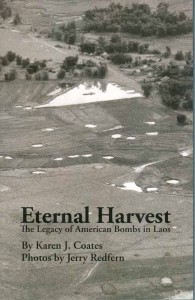 The numbers are staggering. As Karen Coates, author of Eternal Harvest: The Legacy of American Bombs in Laos (2013, ISBN-13 978-1-934159-49-1) states, “To this day, Laos remains, per capita, the most heavily bombed country on earth. All told, the U.S. military and its allies dumped more than 6 billion pounds of bombs across the land—more than one ton for every man, woman, and child in Laos at the time. American forces flew more than 580,000 bombing missions, the equivalent of one raid every eight minutes for nine years…Among all the ordnance dropped were 270 million cluster-bomb submunitions, tiny “bombies” that were packed by the dozens or hundreds into canisters and casings designed to open in midair, scattering baseball-sized explosives across areas as large as a football field. Millions of submunitions fell into forests, where many lodged into treetops and scrub brush. It can take decades for something to jostle them loose. Bombies are the most common form of unexploded ordnance in Laos today.”
The numbers are staggering. As Karen Coates, author of Eternal Harvest: The Legacy of American Bombs in Laos (2013, ISBN-13 978-1-934159-49-1) states, “To this day, Laos remains, per capita, the most heavily bombed country on earth. All told, the U.S. military and its allies dumped more than 6 billion pounds of bombs across the land—more than one ton for every man, woman, and child in Laos at the time. American forces flew more than 580,000 bombing missions, the equivalent of one raid every eight minutes for nine years…Among all the ordnance dropped were 270 million cluster-bomb submunitions, tiny “bombies” that were packed by the dozens or hundreds into canisters and casings designed to open in midair, scattering baseball-sized explosives across areas as large as a football field. Millions of submunitions fell into forests, where many lodged into treetops and scrub brush. It can take decades for something to jostle them loose. Bombies are the most common form of unexploded ordnance in Laos today.”
Coates’ book details how these UXOs (unexploded ordnance) are affecting the lives of rural Laos today, and offers fascinating details on the people and organizations that are trying like mad to find, and defuse or explode them. Travelers to the Plain of Jars, in particular, should take interest in this book: there are valid reasons to stay on marked paths. We here at WoWasis were impressed at some of the technical information in the book, and constantly referred to the drawings and explanations of five “bombies” listed, with figure drawings, on pages 78-99, the BLU-3, BLU-24, BLU-26, BLU-42, and M83. When accidentally triggered, often by people planting crops, these hidden or buried anti-personnel weapons send out numerous pieces of lethal shrapnel over surprisingly large distances. As the author points out, these cluster bombs had a failure rate of roughly 30%, meaning a significant number lay in wait over the Laotian countryside, fodder for accidental triggering. And the result is an estimated 150-2000 casualties per year, ranging from maiming to death.
In addition, larger bombs, including some 750 pound monstrosities, are found unexploded as well. One problem is that selling metal for scrap has become a real income earner for thousands of Laotians, and warnings — sometimes badly heeded — have gone out all over the country to be wary of metals that could be UXO.
Coates focuses much of the book on what is being done, primarily by NGOs (non-governmental organizations), to find and eliminate the bobs and bomblets. It’s a big task, as metal detectors don’t pick up everything, and rains tend to cause previously buried bombs to surface. A particularly interesting chapter focuses on the work of American Jim Harris, who has built a Wisconsin-based NGO around finding and defusing/exploding the ordnance. She also discusses post-war use of bomb and jet fragments. They’ve been made into watering troughs, piers for buildings, and eating utensils (the village of Ban Naphia alone produces about 150,000 aluminum spoons per year).
The book, heavily laden with black and white photos by Jerry Redfern, is recommended for anyone traveling to rural Laos, both as a precautionary measure and as a cultural guide. Those interested in military history, as well, will find it to be an interesting and important coda to the American adventure in Southeast Asia. Buy it now at the WoWasis eStore.
Incredible , and how sad that their homeland still has bombs that could go off any time. In other countries such as the USA, we are so fortunate.